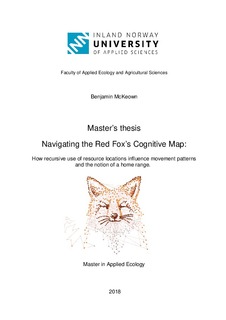| dc.description.abstract | The size and location of an animal’s home range is considered fundamental to the understanding of a species’ dispersion and spatio-ecological requirements. Recent studies suggest that memory and recursive movement strategies have been overlooked in the shaping of home range patterns. It has been proposed that the most apt definition of a home range is: that part of animal’s cognitive map of its environment that it chooses to keep updated. By following fourteen GPS collared red foxes, I investigate how recursive movement and fine scale site or route fidelity, implicative of a cognitive map, shapes red fox space-use patterns. Red foxes showed significant clustering in recorded positions. An average of 43% of fixes were found in clusters that covered a proportional area of only 1.1% of their total range; providing evidence that red foxes use space disproportionately and demonstrate strong recursive use of specific resource locations. Clusters were attributed to clumped food sources, bed or den sites, routes and vantage points in the landscape. Cluster habitat and utility was strongly linked with diel phase. Foxes were more active at night and demonstrated recursive movement to food sources in habitats of greater exposure to humans, under cover of darkness. During the day, foxes were less active and demonstrated extended residence time at established shelter locations. These were in dense vegetation or rugged terrain further from human habitation or farmyards. Foxes demonstrated limited movement time away from cluster locations. My results indicate that memory and an associated cognitive map play a prominent role in optimizing red fox movement patterns in rural landscapes. | nb_NO |
